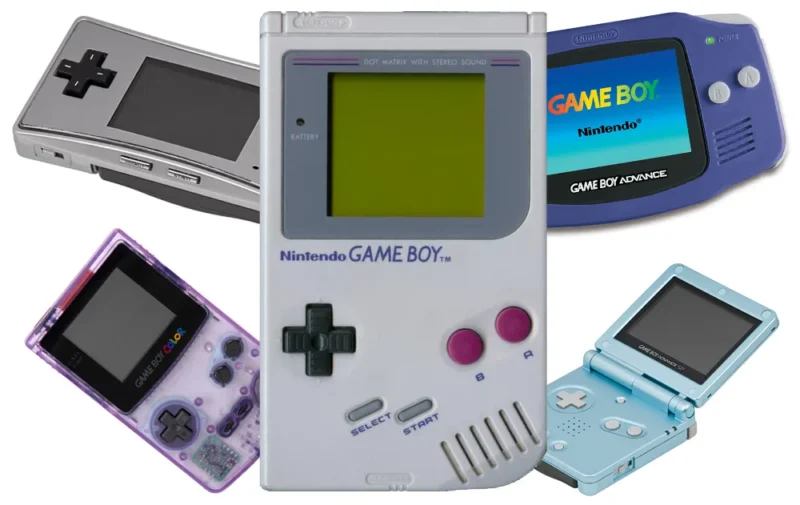 When Nintendo released the Game Boy in 1989, it didn’t just launch a product—it launched a cultural phenomenon. The Game Boy line would go on to sell over 200 million units worldwide and establish handheld gaming as a core part of the industry.
When Nintendo released the Game Boy in 1989, it didn’t just launch a product—it launched a cultural phenomenon. The Game Boy line would go on to sell over 200 million units worldwide and establish handheld gaming as a core part of the industry.
This article explores each version of the Game Boy, highlights the top 10 essential games, and provides guidance on which systems are best for retro gaming today.
🎮 Game Boy (1989)
The Original “Fat” Game Boy was Nintendo’s first foray into portable gaming. With its green-tinted monochrome display, D-pad, and two-button controls, it looked simple but proved revolutionary.
- Monochrome screen with greenish tint
- 10-30 hours on 4 AA batteries
- Instant classic design and portability
Retro Gaming Note: Great for nostalgic charm, but limited by its screen and sound capabilities. Most people emulate GB games via GBC or GBA emulation today.
🎮 Game Boy Pocket (1996)
A sleeker, smaller version with a better screen and improved portability.
- Compact and lightweight
- Improved screen with no green tint
- Required 2 AAA batteries
Retro Gaming Note: Same game compatibility as original Game Boy. A good physical choice for collectors, but not essential for emulation.
🎮 Game Boy Light (1998, Japan Only)
Similar to the Pocket but featured an electroluminescent backlit screen.
- Backlit monochrome screen
- Extremely rare and collectible
Retro Gaming Note: Rare and expensive. Not essential unless you’re a hardware purist.
🎮 Game Boy Color (1998)
Brought full color to the Game Boy line and introduced new cartridge formats.
- Full-color screen
- 8-bit processor with improved speed
- Slim, rounded design
Retro Gaming Note: Essential for playing color-enhanced versions of classics. Best way to enjoy both original Game Boy and GBC-exclusive titles.
🎮 Game Boy Advance (2001)
A 32-bit system with shoulder buttons and wide game compatibility.
- 32-bit CPU
- Shoulder buttons (L and R)
- Backward compatibility with all previous Game Boy games
Retro Gaming Note: The most versatile platform. Can run nearly the entire Game Boy library (GB, GBC, GBA) with better controls and performance.
🎮 Game Boy Advance SP (2003)
Refined version of the GBA with backlight and rechargeable battery.
- Rechargeable battery
- Folding design to protect screen
- Bright screen ideal for all lighting conditions
Retro Gaming Note: Widely considered the best physical Game Boy hardware for retro gaming. The backlit AGS-101 model is especially beloved.
🎮 Game Boy Micro (2005)
Ultra-compact GBA variant with a sharp screen but no backward compatibility.
- Tiny size, highly portable
- Bright, crisp screen
- GBA game compatibility only
Retro Gaming Note: Only good for GBA titles. Best suited for collectors or ultra-portable fans.
🕹️ Recommended Game Boy Platform(s) for Retro Gaming
✅ Best All-in-One System: Game Boy Advance (or SP)
- Plays the widest range of games (GB, GBC, and GBA)
- Best value for space and compatibility
Retroarch & OpenEmu Tip: If you’re emulating, you only need to install a Game Boy Advance core (like mGBA in RetroArch or OpenEmu). Once installed, you can load ROMs from Game Boy, Game Boy Color, and Game Boy Advance into a single GBA folder, and they will all work. The GBA emulator handles backward compatibility just like the original hardware.
✅ For Game Selection + Visuals: Game Boy Color + Game Boy Advance
- Some Game Boy Color games, such as Shantae or Metal Gear: Ghost Babel, pushed the hardware to its visual limits with vibrant palettes and fluid animations.
- Modern emulators like
mGBAemulate GBC functionality fully, even when run through a GBA core. - Game Boy Advance titles offer the most advanced 2D visuals and audio in the Game Boy family. Games like Wario Land 4 and Metroid Fusion showcase the system’s graphical capabilities and sound design.
❗ Skip If You’re Emulating:
- Game Boy Pocket and Game Boy Light (offer no additional compatibility or performance)
- Game Boy Micro (GBA-only)
🔧 Best Handheld Devices for Game Boy Emulation
When selecting a handheld device for emulating Game Boy titles, screen size and aspect ratio are crucial for an authentic experience. The original Game Boy and Game Boy Color featured a 10:9 aspect ratio, while the Game Boy Advance utilized a 3:2 aspect ratio. Here are some top recommendations:
⭐ Miyoo Mini+
- Screen: 2.8-inch IPS display with a 4:3 aspect ratio.
- Pros: Highly portable, excellent for Game Boy and Game Boy Color games.
- Cons: Smaller screen may not appeal to all users.
- Emulation: Runs GB, GBC, and GBA games smoothly using Onion OS.
⭐ Anbernic RG35XXSP
- Screen: 3.5-inch IPS display with a 4:3 aspect ratio.
- Pros: Clamshell design reminiscent of the GBA SP, comfortable for extended play.
- Cons: Lacks analog sticks, which may limit compatibility with some games.
- Emulation: Handles GB, GBC, and GBA titles effectively.
⭐ Analogue Pocket
- Screen: 3.5-inch LTPS LCD with a 1600×1440 resolution, matching the 10:9 aspect ratio of the original Game Boy.
- Pros: FPGA hardware offers near-perfect emulation, supports original cartridges.
- Cons: Higher price point, limited availability.
- Emulation: Exceptional accuracy for GB, GBC, and GBA games.
⭐ AYANEO Pocket Micro
- Screen: 3.5-inch display with a 4:3 aspect ratio.
- Pros: Premium build quality, powerful hardware capable of emulating up to GameCube titles.
- Cons: Higher cost, may be overkill for solely Game Boy emulation.
- Emulation: Excellent performance for GB, GBC, and GBA games.
⭐ Retroid Pocket 5
- Screen: 5.5-inch OLED display with a 16:9 aspect ratio.
- Pros: Powerful hardware, versatile for various emulation needs.
- Cons: Widescreen aspect ratio may not perfectly match original Game Boy games.
- Emulation: Capable of running GB, GBC, and GBA games with ease.
⭐ FPGBC (FunnyPlaying Game Boy Color FPGA)
- Screen: 2.6-inch IPS display, closely matching the original Game Boy Color.
- Pros: FPGA-based hardware offers authentic Game Boy Color experience; supports original cartridges; excellent build quality.
- Cons: Assembly required; limited to GB and GBC games.
- Emulation: Not applicable; runs games natively without emulation.
⭐ Powkiddy RGB30
- Screen: 4-inch 720×720 IPS display with a 1:1 aspect ratio.
- Pros: Square screen ideal for GB and GBC games; affordable price point; good battery life.
- Cons: Build quality may feel less premium; performance may vary with more demanding systems.
- Emulation: Excellent for GB, GBC, and GBA games; supports various retro systems.
⭐ TrimUI Smart Pro
- Screen: 5-inch 720p display with a 16:9 aspect ratio.
- Pros: Affordable; large screen; decent performance for retro games.
- Cons: Widescreen aspect ratio may not be ideal for GB/GBC games; controls may feel less responsive.
- Emulation: Suitable for GB, GBC, and GBA games; performance may vary with more demanding systems.
When choosing a device, consider the screen’s aspect ratio and size to ensure the best possible experience for Game Boy emulation. Devices like the Analogue Pocket and Anbernic RG35XXSP offer screens that closely match the original Game Boy’s display, providing a more authentic feel. For those seeking portability, the Miyoo Mini+ is an excellent choice, while the AYANEO Pocket Micro and Retroid Pocket 5 cater to users desiring broader emulation capabilities.
👁️ Top 10 Game Boy Games (Spanning All Generations)
These 10 titles represent the Game Boy platform’s legacy, influence, and diversity across its many forms — without relying on Pokémon entries:
- Tetris (GB) – The killer app that sold millions of Game Boys
- The Legend of Zelda: Link’s Awakening (GB/GBC) – A full Zelda adventure in your pocket
- Metroid II: Return of Samus (GB) – Essential for Metroid lore, and later remade as Samus Returns
- Super Mario Land 2: 6 Golden Coins (GB) – Introduced Wario and massive improvement over the first game
- Wario Land 4 (GBA) – One of the most polished platformers on the GBA
- Advance Wars (GBA) – Addictive tactical gameplay with incredible replayability
- Castlevania: Aria of Sorrow (GBA) – Metroidvania perfection on handheld
- Fire Emblem (GBA) – First English release of the legendary series
- Shantae (GBC) – One of the most visually impressive and technically ambitious GBC games
- Metal Gear: Ghost Babel (GBC) – A brilliant stealth-action experience uniquely crafted for handhelds
In every iteration, the Game Boy combined intelligent design, great games, and legendary portability. Whether it was the green screen of the original or the sleek form of the Micro, Nintendo’s handheld legacy began with a simple idea: great games, anywhere.

Leave a Reply